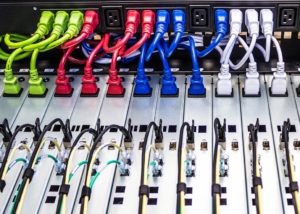Throughout the world, power cord is widely used in our daily life, data centers and other professional fields. There are various power cords equipped with different types of connectors in different countries, from type A to type N. Among all these types, C13 and C15 power cords are two most commonly used plug type C power cords. People may easily get confused by C13 vs C15 power cord. What’s the difference between them? The answer is here.
C13 and C15 power cords are two types of power cords defined by different connectors. So before we touch the question, let’s understand the concept of power cord. Power cord is an electrical flexible cord with connectors at each end. One is a male plug and the other is a female receptacle. In actual application, the male inlet is attached to a power supply such as PDU power strips while the female connector attached to an electrical appliance or equipment. IEC (International Electrotechnical Commission) uses odd numbers to stand for female outlets, and 1 bigger even numbers to stand for the matching male inlets. Each power cord has been standardized by IEC before introduced in the market. Different types of connectors are specified for different combination of rated current, voltage and temperature.
 This figure is a display of power cord application.
This figure is a display of power cord application.
C13 power cord consists of a supple cable, a female C13 connector at one end and a male C14 appliance inlet at the other end. In this way, the combined unit of C13 power cord is shown as C13 to C14. C13 power cord is called as “kettle cord” in our life, however, the rated temperature of C13 is 70℃, not high enough to support a electric kettle. C13 is commonly used in PCs, printers, monitors and instrument amplifiers.
At the first sight of C15 power cords, one can see nothing different from C13 but a notch opposite the earth. This slight difference is designed for figuring C15 from C13, forbidding misuse of different rated temperature connectors. C15 power cord is matched with C16 appliance inlet, shown as C15 to C16. It is noted that C15 connector also fits into C14 inlets while C13 cannot fit into C16 inlets. Because higher rated voltage power cord can be used in lower voltage equipment, not vice versa. C15 is designed for high temperature conditions with a rated voltage up to 120℃. For instance, it can be used for devices like electric kettles and computing networking closets.
The following table shows a comparison between C13 vs C15 power cord.
| Connector Type | C13 | C15 |
| Ground Post | Yes | Yes |
| Rated Current/Voltage | 10A/250V | 10A/250V |
| Shape Characteristic | No notch
|
A notch opposite the earth
|
| Appliance Inlet Type | C14 | C16 |
| Temperature Rating | 70℃ | 120℃ |
| Applications | PCs, printers, monitors, instrument amplifiers to fixed-configuration switches. | Electric kettles, computing networking closets, sever rooms, PoE switches with high wattage power equipment. |
As the table shown, C13 and C15 both are 3-hole power cords with earth touch, and defined with same rated current and voltage. However, they have distinct features in shape characteristic, appliance inlet type, temperature rating and applications. C15 is a better choice in high temperature surroundings.
This article introduced the concept of power cord, C13 and C15, then focused on one question-C13 vs C15 power cord: What’s the difference? It made a contrast from four aspects: shape characteristic, appliance inlet type, temperature rating and applications. At last a conclusion is made that C13 and C15 are totally different power cords. Comparing with C13, C15 is a natural fit for high temperature application, so next time you need a power cord applied to high temperature condition, take C15 rather than C13.


